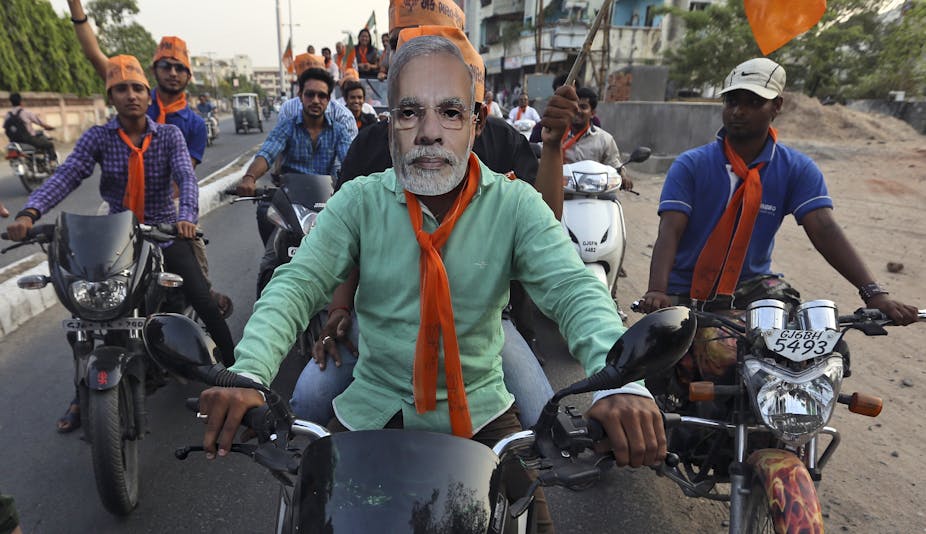In 2004, students in the north Indian city of Meerut, Uttar Pradesh, started a club called Generation Nowhere. They met to discuss the hopelessness of their position as educated young men from provincial backgrounds. They had little hope of getting government jobs, and their degrees were worth little in the nearby metropolis of Delhi.
There is a new mood of cautious optimism in Meerut, however. As the Indian elections reach their climax, there is a sense that something might be about to change. I have been investigating this issue with Jane Dyson at the University of Oxford as part of an ongoing research project on the political actions of the educated unemployed youth of South Asia.
Lok Ram wears a saffron bandana tied around his head – saffron is the colour associated with the Hindu nationalists in India – and talks confidently about transformation. “Change is definitely about to happen” he says. “Narendra Modi [leader of the Bharatiya Janata Party (BJP)] is poised to claim victory. All that is left is to decide on our coalition partners.”
Others are more sanguine. Another student, Uday, who is poorer than Lok Ram, said that he supported the Aam Admi Party (Ordinary People’s Party) established recently to challenge the political establishment. But he said that the Aam Admis are unlikely to win many seats. “Politics will not give us what we want.”
Development agenda
Students in Meerut want three things. First, they seek development. Uttar Pradesh is on a par with many countries in sub-Saharan Africa with regard to development. In terms of gender indicators and sanitation, it is worse.
Students in Meerut, who are typically from the surrounding countryside, complain constantly of teacher absenteeism in local schools, non-functioning government hospitals, and the pitiful amount of money that reaches the villages for development projects. The Indian government launched a massive National Rural Employment Guarantee Scheme in the mid-2000s. But students are dismissive about this scheme. “It is like a cumin seed in a camel’s mouth,” one said glumly.
The second thing young people want is employment – not the temporary quick-fix jobs that they can get in the informal economy in Meerut, as bodyguards on private college campuses or salespeople for large pharmaceutical firms. Young people want proper (pukka) jobs: as government servants or well-paid corporate executives.
Students say they suffer relative to their peers in Delhi because they lack English-language training, advice on careers, and good quality local education in technical spheres. The consensus is that the main political parties, while paying lip service to these types of issue, do not really understand students’ problems. “We are just like the cuckoos who stare at the sky with our mouths open hoping that something will drop in,” said one.
Triple-headed crisis
A third issue burning a hole in students’ minds, one intimately connected to the first two, is that of corruption. Following large social movements against corruption, associated especially with the social activist Anna Hazare, students are aware of the collective desire for change. They also say that as “the next generation” they have a responsibility to counter corruption. “We can do it,” is the general attitude. “Even if it will take a very long time.”
Which of the main contenders in the Indian elections are most likely to tackle the triple-headed problem of underdevelopment, unemployment, and corruption? The Congress Party, which has dominated Indian politics for much of the post-independence period, comes out badly. Students see Congress as tainted by dynastic politics and as representative of the “status quo”.
The Aam Admi party is treated either with reverence or laughter, depending on whom you ask. Most students will tell you that it has noble aims but lacks the popular base to really succeed on the national scale. “It will take ten more years,” the students say. Even the party’s supporters concede as much.
Modi gaining ground
Modi is more popular. Students are well aware of Modi’s reputation as a staunch Hindu nationalist who might discriminate against Muslims in the future, but most regard this issue as irrelevant in terms of his success as a prime minister.
“The Hindu nationalist issue is something different,” Hindu students often say. “The important thing is that he is a good leader.” Muslims dissent; they see Modi as “a very dangerous man”. But many Hindus among students, even those who were not BJP supporters in the past, are coming round to Modi.
He is seen as a moderniser. They like his emphasis on creating jobs through encouraging corporate investment. They like his emphasis, too, on technological change, and his claim that India is no longer a country of villages but one of urbanisation. To term this “support” is perhaps overcooking things: it might be more prudent to simply state that students dislike Modi less than other leaders.
Still, there is a groundswell of opinion that Modi represents the immediate future of India, and that this will not be the disaster that his liberal critics predict. “Forget about the religious aspect.” is how students often put it. “Modi is the man.”

